Lorna Fencer and Yam Dreaming – An Interview with Didier Zanette
Didier Zanette is passionate about art from the Pacific. He spends six months of each year living in New Caledonia and travels throughout the Pacific collecting indigenous art for his three galleries. In this interview he talks with David Wroth about his passion for indigenous Australian art and the upcoming exhibition of Lorna Fencer he is organising in Paris.
Q: Can you tell me a little about your background and how you came to be involved in the art world?
From a very young age I was in touch with the art world through my parents, who were collectors of African art. I was born and lived in Morocco for 15 years. Then I travelled to La Reunion Island, which is close to Mauritius in the Indian Pacific. Then I went to New Caledonia in the Oceanic part of the world. I've always been in contact with art in these different parts of the world. I didn't work all the time in the art business because I started as a banker first, but very quickly, I stopped work at the bank to follow my passion for art and specifically Pacific art.
Q: You're taking this Lorna Fencer exhibition to Paris. Can you tell me about how you hope the audience there will respond to the work?
First of all, I must say that the choice of Lorna is a personal choice. When I say personal, I involve my wife Isabelle, who is very attracted by Lorna's painting. Like I said, it's a real coup de coeur. In French, it means you cannot say why and how it happens, but we just love these paintings. I think that people may need some time to appreciate Lorna Fencer. It’s very powerful and colorful too. It could take time for the art buyer customer in France, to come to fully appreciate it, but I want to bet on this artist.
Q: You've been working with Pacific Islander cultural material for several decades. What drives the European interest in these artifacts and artworks?
Firstly it's art from the opposite end of the world. The European people don't know a lot about these artifacts or these materials. I think that they want to know more about these other parts of the world. We are now in a world of rapid communication with the internet. Everybody is looking for something new and interesting. I came to the Pacific part of the world 25 years ago and immediately became interested in this field of artifacts and artworks. I always wanted to share my passion for this art with other people. That's why I opened 3 galleries in Europe and in New Caledonia.
Q: Is there some element that you're particularly passionate about?
I have the chance to work with the 3-dimension and 2-dimension artworks, so the paintings and the Aboriginal art are of particular interest to me. I try to develop the Papua New Guinea contemporary art too, Fijian art too and Vanuatu contemporary art. It's been a long time. For the last 25 years, I've been developing my interest in this art. I think it's good to help the people in Europe learn about this art. It’s sad that it’s taken so long for the Europeans people to be aware of it. Really the broader awareness only just it started in 2006 with the opening of The Musée du quai Branly. I'm passionate about this art. I travel a lot. I meet a lot of people in different islands of Pacific. I buy a lot of artworks, carvings, masks from Papua New Guinea, Solomon Islands and Vanuatu and New Caledonia. I love these works.
The Artist Lorna Fencer
Q: How did you come to know about Lorna's work?
About 5 or 6 years ago I met a man called Cornelius. He's a guy who was working with Lorna. When he showed us the paintings, we had such a shock. We just loved them so much. We weren’t really in a position to invest that much at the time, but we wanted to. We bought, I think, 10 paintings at that time. It was a lot for us, but we just liked them so much. That was the first time.
Q: It was an instant reaction?
It was an instant reaction. We didn't need any time to think. We loved the work straight away. Maybe it’s because we’ve seen so many other works before and these stood out. I don't know. I can't explain it really. She was the artist who touched us the most at that time. I then met you here at Japingka and you showed me more of beautiful paintings by that artist.
Q:What type of response do you find in France, when your customers come into your Aboriginal galleries?
They find that it's a colorful art. It's an old and contemporary art, old like the Aboriginal people were painting 50,000 years ago on the caves. Now they adapt to this new world. The painting is exceptional for the creativity, the use of the colors. There is also the important stories behind the art. The French people like some intellectual thinking about the painting. I think the Aboriginal art gives both of what they need: the visual impact and the beautiful stories. It’s perfect.
Q: Can you tell me a little about the awareness of Aboriginal art in France generally?
It started in France in the 1980s with the big show called Les Magiciens de la Terre. Magiciens de la Terre in Beaubourg. Beaubourg is a very big place in Paris, a contemporary art museum. Some Aboriginal artists came and painted some art on the ground. It was, I think, one of the first time the public had seen Aboriginal art. Recently there’ve been some exhibitions in Montpelier.
The Musée du quai Branly
Then in two years ago in 2012 The Musée du quai Branly opened the biggest exhibition of Aboriginal art in France. It lasted 4 months. The book, which was made for the exhibition was sold out the first week. This art exhibition attracted so many people. It was one of the best shows ever put on at The Musée du quai Branly. I think French people are very interested in Aboriginal art now. There is before quai Branly and now after quai Branly. It was such a good show. Now they would like to know more, and it's time to do this exhibition with the help of David and Japingka.
Q: Can you tell me some more about the Musée du quai Branly and its influence in promoting indigenous art?
I’ve been in this business, indigenous art, for long time now. Like I said, before Musée du quai Branly opened, business was okay, but when Musée du quai Branly started to do exhibitions, more customers came in my galleries to buy. I think Musée du quai Branly did a lot to open up the market for indigenous artists.
Q: They've been very powerful in breaking through to a broader population?
Absolutely. I think it attracts so many visitors, each exhibition. It's, I think, the best publicity and advertising for art from this part of the world.
Q: Do you think that Lorna's story would be accessible to viewers of her artwork in France?
Yes, I’m hoping so. It will be accessible because I'm writing a book about it. It's written in French, so I think it will be very accessible to the customers. Paris is one of the centers in the world for art. If we do that solo exhibition with Lorna, it's also promoting her all around the world too because people we will know we made the solo exhibition for her.
Q: Can you tell me about the title for Lorna Fencer exhibition?
Oh yes. The title of the exhibition is Poems of the Yam because the yam is very important. Most of the paintings of Lorna Fencer are about yam dreaming. We tried to relate it with the Papua New Guinea culture because they celebrate some of the same things. Both tell important yam stories. We called the exhibition Poems because it's poetic.
Q: In the first pages of your exhibition book you have on one side Lorna Fencer art and next to it images from Papua New Guinea. Can you tell us a little about that?
There are complex paintings of Lornas with a lot of colors. These belong to her, these powerful visuals. On the page opposite we’ve put an image of very tightly woven mask made by the Abelam people of North Papua New Guinea. This tiny and very fine work. I think that it gives power to the painting to see how people like the yam in this other area of the Pacific. Yam is the source for food, but it's also a way to connect to the ancestors. You cut a piece of yam or you put it in the ground, and another yam grows. It's like you can talk to your ancestors through the yams. It's very important for these people. There is something very interesting when you put the images together.
Q: How difficult is it to get across those notions of custodianship and identity to Europeans?
We need time to write about that, to explain and to give some support information. It's complex, the Aboriginal cultural question. It's very complex. Some anthropologists do their best to write in French, but not often. All the books are in English, and the French are lazy about reading in English. Our job in the gallery is to inform the people about this Aboriginal people and to talk about it with them. We try to tell the stories with all the details.
Q: What's valuable to you? What do you love about Aboriginal art?
The stories. The origin of this art is the oldest art in the world. In fact, it's older than European art. In France, we have La grotte de Lascaux, Lascaux Caves. It's only 17,000 years old. Here in Australia, there are paintings that are 50,000 years old. There is a big difference between these 2 cultures. What is important to say is that the art is very rich visually. It's so different, so powerful. We are passionate about the fact that it's old art and contemporary art at the same time.
Q: The ancient tradition is attractive. The story is attractive to you. The power of the visuals attracts you.
Yes, that's the three main factors.
Q: Didier thank you for your time.
My pleasure.

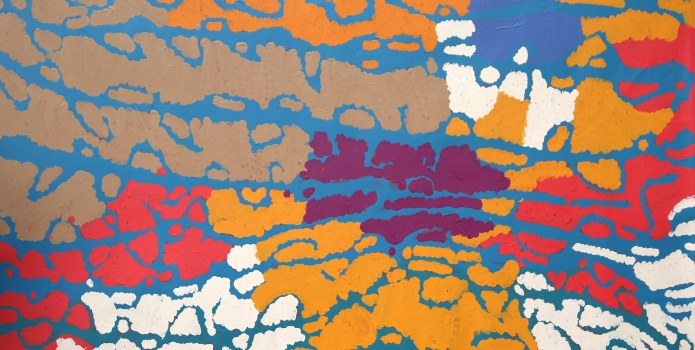
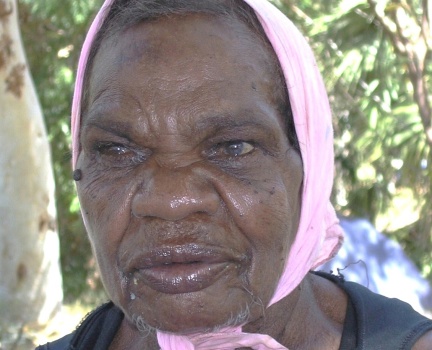
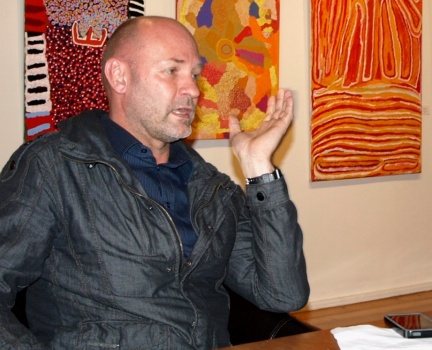
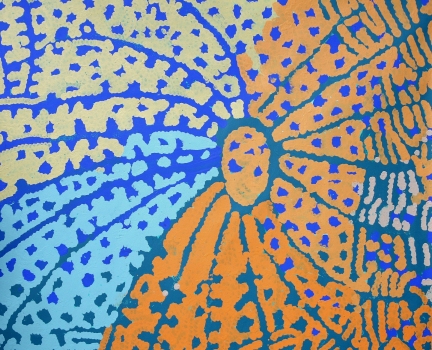
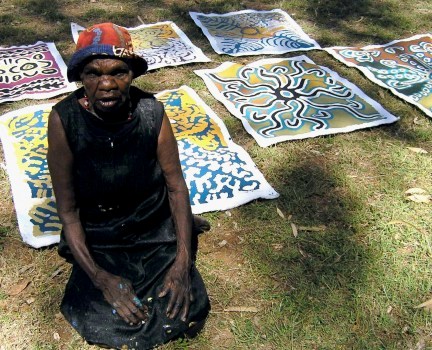
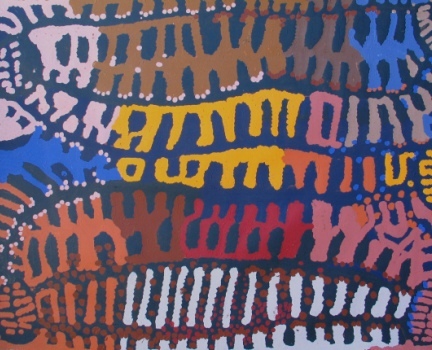
![Intel(R) JPEG Library, version [2.0.14.46]](https://japingkaaboriginalart.com/wp-content/uploads/Article-Didier-2.jpg)